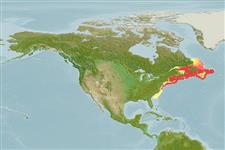Preferred temperature (Αναφ.
123201): 0.9 - 7.8, mean 4.9 °C (based on 155 cells).
Phylogenetic diversity index (Αναφ.
82804): PD
50 = 0.5000 [Uniqueness, from 0.5 = low to 2.0 = high].
Bayesian length-weight: a=0.00479 (0.00399 - 0.00575), b=3.11 (3.06 - 3.16), in cm total length, based on LWR estimates for this species (Ref.
93245).
Τροφικό Επίπεδο (Αναφ.
69278): 4.5 ±0.4 se; based on diet studies.
Generation time: 3.4 (2.7 - 4.3) years. Estimated as median ln(3)/K based on 10
growth studies.
Ελαστικότητα (Αναφ.
120179): Μεσαίο(α), ελάχιστος χρόνος για διπλασιασμό πληθυσμού 1,4 - 4,4 έτη (K=0.18-0.4;tm=2-3; tmax=12).
Prior r = 0.26, 95% CL = 0.17 - 0.39, Based on 3 full stock assessments.
Fishing Vulnerability (Ref.
59153): Moderate to high vulnerability (54 of 100).
🛈
Climate Vulnerability (Ref.
125649): Moderate to high vulnerability (47 of 100).
🛈
Nutrients (Ref.
124155): Calcium = 12.4 [6.5, 37.8] mg/100g; Iron = 0.245 [0.086, 0.595] mg/100g; Protein = 17.7 [16.6, 18.7] %; Omega3 = 0.276 [0.189, 0.400] g/100g; Selenium = 28.2 [14.6, 52.4] μg/100g; VitaminA = 17.2 [4.9, 58.6] μg/100g; Zinc = 0.279 [0.197, 0.387] mg/100g (wet weight);
